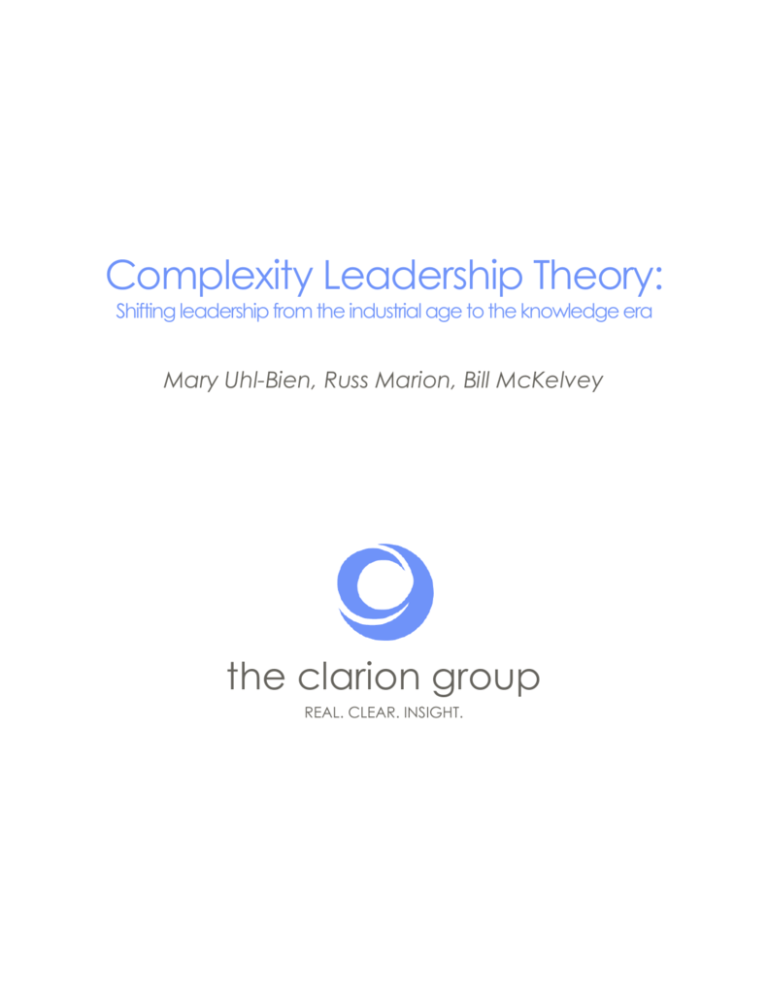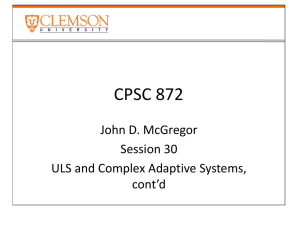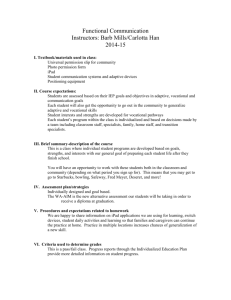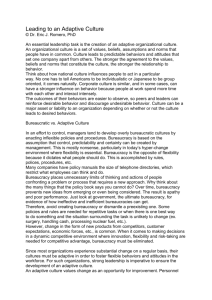Complexity Leadership Theory
advertisement

Complexity Leadership Theory: Shifting leadership from the industrial age to the knowledge era Mary Uhl-Bien, Russ Marion, Bill McKelvey the clarion group REAL. CLEAR. INSIGHT. Abstract: The most widely used leadership models today are rooted in top-down bureaucratic models. While these models are effective in stable, production-oriented economies, they are not wellsuited for the less stable, knowledge-oriented economy that describes the current environment. Rather, the study of complexity science supports a new model, the Complexity Leadership Theory, which describes leadership as a complex interactive dynamic that promotes the emergence of adaptive outcomes (learning, innovation, adaptability). It is a leadership framework that enables the learning, creative, and adaptive capacity of Complex Adaptive Systems (CAS) within the context of knowledge-producing organizations and describes three interacting leadership roles: administrative, adaptive, and enabling. These three leadership roles represent the necessary and inevitable interaction between an organization’s bureaucratic, administrative functions and its emergent, informal CAS dynamics. Article abridged from its original 2007 publication in The Leadership Quarterly Page 2 Introduction The transition from the 20th Century to the 21st Century has marked a clear change from the Industrial Era to the Knowledge Era, where knowledge, constantly increasing and being shared, is now a core commodity. Additionally, the technological revolution and globalization of business has ensured a complex, competitive and ever changing business environment and yet businesses are still performing under 20th Century leadership models. In order for a business to compete successfully in the Knowledge Era, it must perform under a more relevant leadership style. Core elements of the proposed leadership theory are Complex Adaptive Systems (CAS), which are defined as changeable structures with multiple, overlapping hierarchies that are linked with one another in a dynamic, interactive network. A similar structure has been described as “temporary constellations of people and units”. They are structures that are capable of creative problem-solving, learn and adapt quickly, and emerge naturally in social systems. The proposed Complexity Leadership Theory (CLT), which is based on the dynamic capabilities of CAS, focuses on the strategies and behaviors that foster organizational and subunit creativity, learning, and adaptability that emerge when the right CAS dynamics are activated. CLT includes three broad types of leadership: (1) administrative leadership based on traditional, hierarchical bureaucracy, (2) adaptive leadership, a generative dynamic on which emergent change activities depend, and (3) enabling leadership, which structures and enables conditions that allow CAS to address creative problem-solving, adaptability, and learning. CLT is based on several important ideas. One is context: CAS and leadership are socially constructed in and from a context consisting of interactions and interdependencies among agents (people, ideas), hierarchical divisions, organizations and environments. A second important notion is a distinction between leadership and leaders. CLT’s definition of leadership is that it can come from anywhere, is emergent, interactive, dynamic, and produces adaptive outcomes, whereas leaders are individuals who create the environment which influences this dynamic and the outcomes. CLT will focus on the concept and process of leadership. A third crucial idea is the distinction between leadership and managerial positions. CLT will focus on adaptive leadership, which occurs in emergent, informal dynamics throughout the organization rather than on formal administrative leadership. The last important notion is that of recognizing that leadership in the Knowledge Era occurs in the face of adaptive challenges rather than technical problems, which are more characteristic of the Industrial Age. Part 1: Leadership in the Knowledge Era The Knowledge Era is defined by its competitive landscape that is shaped by globalization, technology, deregulation, and democratization. It is an environment in which a company’s success depends on its ability to promote faster learning and lies more in its social assets (corporate IQ and learning capacity) than in its physical assets. Whereas, in the 20th Century industrial economy, the challenge was to optimize production and physical flow of products, the goal in the 21st Century economy is to create an environment where knowledge accumulates Page 3 and is shared at a low cost, and to cultivate, protect, and use difficult to imitate knowledge assets. In the Knowledge Era, there is an intense focus on speed and adaptability. Further, while companies in the Industrial Era emphasized a simplification and rationalization of its environment, companies in the Knowledge Era must focus on increasing their complexity to the level of the environment in order to optimize their capacity for learning, creativity, and adaptability. Although business has entered a new age, leadership theory remains grounded in an Industrial Era bureaucratic framework. One example of this is the traditional idea that goals are rationally conceived and that managerial practices should be structured to achieve those goals. Another is that leaders are traditionally thought to be able to influence others towards desired objectives within the formal top-down, hierarchical framework. The CLT will address the contradiction between centralized power found in bureaucratic systems still in use today and the needs of the Knowledge Era by focusing on leadership that is grounded in complexity rather than in bureaucracy. CAS are the foundation of that complexity, primarily, the interdependent interactions of agents within CAS, agents with CAS, and CAS with CAS. They are able to adapt rapidly and creatively to environmental changes, and enhance their capacity for adaptive response by diversifying their behaviors or strategies. Types of adaptive responses to environmental changes include counter-moves, altered or new strategies, learning and new knowledge, new allies, and new technologies. The CLT aims to enable adaptive responses to challenges through network-based problem solving, offers tools for knowledge-producing organizations dealing with rapidly changing, complex problems, and is also useful for firms dealing with less complex problems and that are seeking creativity. Part 2: Complexity Leadership Theory CLT is a framework for leadership that enables the learning, creative, and adaptive capacity of CAS. At the same time, it enables control structures appropriate for coordinating formal organizations and producing outcomes appropriate to the vision and mission of the system. How can organizations enable and coordinate CAS dynamics without suppressing their adaptive and creative capacity? CAS are intensely adaptive and innovative, possessing the flexibility to adapt and the capacity to coordinate. Its auto-coordination is derived from informal but interdependent structures and activities; it emerges naturally from system dynamics and is not imposed by authorities. This informal interactive interdependency, or the spontaneous emergence of behaviors and changes from network dynamics, is referred to as informal emergence. Informal emergence and auto-coordination are not necessarily incompatible with administrative coordination. When interdependent relationships create informal emergent constraints and Page 4 when actions external to the informal dynamic (such as environmental restrictions or administrative controls) create constraints, coordination emerges. In businesses with a bureaucratic, hierarchical organizational structure, administrators influence complex adaptive systems by imposing external coordinating constraints and demands. But this hierarchical coordination can inhibit the effectiveness of complex adaptive systems when it imposes the knowledge of a few onto the rest of a complex, neural network. To strike the balance between administrative coordination and complex adaptive dynamics, managers should aim to enable informal emergence and should coordinate the contexts within which it occurs, thus expanding the manager’s responsibilities beyond aligning worker preferences with centralized organizational goals. Part 3: A Framework for Complexity Leadership Theory The Three Leadership Functions of the Complexity Leadership Theory Administrative Leadership Individuals and groups in formal managerial roles plan and coordinate activities to accomplish organizationally-prescribed outcomes in an efficient and effective manner Focuses on alignment and control Represented by hierarchical and bureaucratic functions of organization Adaptive Leadership Adaptive, creative, learning actions that emerge from the interactions of CAS as they strive to adjust to tension Informal emergent dynamic that occurs among interactive agents Not an act of authority Enabling Leadership Catalyzes optimal conditions for adaptive leadership Manages entanglement between bureaucratic (administrative) and emergent (adaptive) functions of organization Entanglement refers to the intertwinement of the formal, bureaucratic (administrative) forces with the informal CAS (adaptive emergent) forces of social systems. Administrative leadership may work in conjunction with adaptive leadership or stop it with overly bureaucratic control structures. Adaptive leadership can rebel against administrative leadership, increase its strategic needs, or function independently from it. Enabling leadership exists primarily to enable adaptive leadership, but must also foster the conjunction of adaptive and administrative leadership. A need for administrative and adaptive leadership to co-exist and work in tandem exists because bureaucracy cannot be disentangled from CAS in a formal organization. They necessarily interact with each other – there are times when one must be emphasized more than the other. For example, in a stable environment, the organization may emphasize a rationalized, hierarchical structure to enhance profits. But during a time of change and intense competition, the organization will emphasize complexity and CAS. 3 A. Administrative Leadership Page 5 Administrative leadership, being the bureaucratic function, is defined as the actions of individuals in formal managerial roles who plan and coordinate organizational activities. Examples of tasks that administrative leaders perform include structuring tasks, planning, building vision, acquiring resources, managing crises and personal conflicts and managing organizational strategy. Inherent in administrative leadership is the power to make decisions for the organizations, since it is a function based on authority and position. But under the CLT, administrative leadership should be conscious of its power over the firm’s creative, learning, and adaptive capabilities (adaptive leadership). For example, it should not pursue profitable efficiency in an unstable environment where adaptive capabilities will be needed. 3 B. Adaptive Leadership Adaptive leadership is defined as an interactive, collaborative dynamic that produces adaptive outcomes in a social system. It originates in struggles over conflicting needs, ideas or preferences and results in alliances of people, ideas, technologies, and cooperative efforts. It is a complex dynamic and a key source of change in an organization. Asymmetrical interaction causes adaptive leadership to emerge. A one-sided, authority-based asymmetrical interaction leads to a top-down or bureaucratic leadership event, but asymmetry that is less one-sided and driven by differences in preference will lead to a leadership event more based on interactive dynamics. Differences in preference will foster adaptive change outcomes, since conflicting ideas, knowledge, and technologies inspire new knowledge, creative ideas, and learning. An example of this is gaining new understanding of a situation when debating an opposing perspective. Recognition of adaptive leadership occurs when it has significance and impact. Significance in this context is defined by the expertise of those who generated the adaptive moment and by their capacity for creative thinking. Impact is influenced by the authority and reputation of the agents in question, by the degree to which the implications of the idea are understood or by the degree of success it has in generating enough support to create an impact. Characteristics of Adaptive Leadership Network Dynamics The contexts, mechanisms (dynamic patterns of behavior that produce complex outcomes) that enable adaptive leadership Contexts include networks of interaction, patterns of conflicting constraints or tension, direct/indirect feedback loops, rapidly changing environmental demands Mechanisms include resonance (correlated action) and aggregation of ideas, catalytic behaviors, information flow and pattern formation, nonlinear change Interaction of agents and CAS produce ideas and Page 6 knowledge; interaction of ideas and knowledge produce even more complex ideas and knowledge Primary output: adaptability, learning, creativity Emergence Involves self-organization (resonance), reformulation of existing elements to produce outcomes distinct from original elements Reformulation: amplification, transformation, combination of multiple interacting, often conflicting, elements under conditions of tension; product of complex interactive mechanisms; outcomes can be unpredictable Resonance: behaviors of two or more agents are interdependent Self-organization is therefore defined as different reformulation activities finding common cause Multi-level Adaptive Leadership Emergent outcomes, significance, impact of adaptive behaviors differ across hierarchical levels Upper hierarchical level adaptive outputs: emergent planning, resource acquisition, strategic relationships with environment Middle hierarchical level adaptive outputs: emergence of focused planning, resource allocation Lower hierarchical level adaptive outputs: development of an organization’s core products, including knowledge development, innovation, adaptation 3 C. Enabling Leadership Enabling leadership in the CLT seeks to cultivate conditions (contexts, complex networks) that catalyze adaptive leadership. It promotes these networks by fostering interaction and interdependency and by injecting adaptive tension. Interaction, creating the network across which information moves, is the first catalyst of ideal network conditions. While enabling leaders cannot create the connections that lead to an effective network, they can create the general structure of complex networks and the conditions that will allow them to develop from an organizational level (e.g., open architecture work places, self-selected work groups, electronic work groups). At the strategic level, enabling leadership helps promote interactions between organizational CAS and environmental dynamics. This enables the use of new information into the creative dynamic and it increases the organization’s capacity to adapt to environmental changes and conditions. Individual agents can act in an enabling role by widening their personal networks, monitoring their environment, and keeping themselves informed of issues important to the firm and its field. Agents in a system must go beyond interacting to functioning effectively and complexly; they must also be interdependent, a characteristic that creates pressure to act on information. One way to encourage interdependency is to allow measured autonomy which will permit the Page 7 emergence of conflicting constraints and enable agents to work through those constraints without formal authorities interfering. The CLT urges administrative leaders to resist creating an environment in which workers bring problems to management, as interventions of this type can stifle interdependency and adaptive mechanisms. At the strategic level, enabling leaders can promote interdependency with rules that encourage coordination. At the individual level, enabling leaders or agents can refine their information relative to that of other agents, contributing to the co-elaboration of ideas and information that creates a potential to discover new information. Lastly, enabling leadership aims to foster tension. Heterogeneity (differences in skills, preferences, and perspectives among agents) can enhance internal tension by stimulating interdependency. Its value, in an interdependency context, lies in encouraging agents to adapt to their differences. In the upper organizational levels, enabling leadership can foster heterogeneity by creating an organizational norm of respecting diversity and tolerating divergent perspectives on problems, and by structuring work groups that will interact with diverse ideas. Enabling leadership can also foster external tension (injected tension that is not a natural characteristic of informal dynamics). Upper and mid-level enabling leaders can promote this tension with managerial challenges and by creating demands for results, which ultimately aim to foster creativity and learning. At the individual level, instead of looking to authority for answers, agents can commit to the adaptive problem solving process. They can also embrace task conflicts and expose a working group to diverse perspectives. An additional function of enabling leadership is to manage the entanglement between administrative and adaptive leadership. It also aims to facilitate the integration of creative solutions and outcomes into the formal system. Accomplishing this involves using authority, access to resources, and influences to encourage the conjunction of formal and informal organizational systems. Enabling leaders helps protect the CAS from top-down hierarchical systems of authority by influencing administrative leadership and helping to align organizational strategy to accommodate the needs of adaptive structures. CLT has concerns about whether administrative planning might hinder creativity, but also acknowledges that creative and adaptive behaviors need to be focused, at the risk of compromising the organization’s strategic mission. It proposes striking a balance by using a creative planning model that includes idea identification, plan development, and plan execution and suggests that the planning model imposes certain limitations to ensure that the creative outputs of the process are consistent with the core themes of the organization. At the same time, the creative process itself should be separated from administrative planning and coordination. Enabling leaders also coordinates the acquisition and allocation of resources that will increase the availability and flow of information, thereby supporting the creative, learning, and adaptive capabilities of CAS. Lastly, enabling leaders should influence the direction of adaptive behaviors to be consistent with the organization’s strategy and mission by articulating a mission that allows for enough flexibility to support the creative process. Enabling leadership is needed to help facilitate, orchestrate, and share innovative ideas and outcomes throughout the organization, since formal organizations inherently tend to inhibit the Page 8 transfer of innovation into the organization. It also works with adaptive and administrative leadership to decide which creative outputs are most appropriate to pursue and incorporate into the broader bureaucratic structure. Conclusion Complexity Leadership Theory, which is based in complexity science, was developed with the consideration that leadership is too complex to be attributed to the acts of only an individual or individuals, and is rather a complex relationship of many interacting forces. It focuses on the complex interactive dynamics of Complex Adaptive Systems and introduces three types of leadership: administrative, adaptive, and enabling. In sum, CLT offers a new perspective of leadership and leadership theory that will aid organizations in their transition from the 20th Century Industrial Age to the 21st Century Knowledge Era. Page 9








